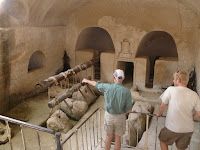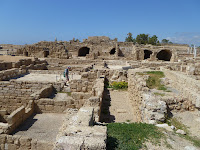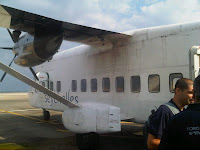May brought with it our first house guest from the U.S., which gave us our first significant motivation to get out and see the country of Israel.
After a day of adjusting to his 10 hour time difference, we took dad on a day trip up north. We started with the Banias waterfall in the
Galilee. Although I managed to pack sandwiches, drinks, and bring the travel guides, I didn't think to look up the weather. It was the first of May, so we're in the dry season, right? As we got into the upper Galilee, it rained. A lot. And I didn't bring a raincoat. We were in shorts. And sneakers. At the entrance to the waterfall trail, we saw the other tourists washing their shoes off. We were in for a muddy trek! Who would have expected thick, sticky mud on the trail in the middle east?
Our second stop was the
Nimrod Fortress. These relatively young ruins, from the Crusades during the 1200's, sat on a hilltop that was almost too cold to walk through! We ventured on though, and were rewarded with very little company. This afforded us a particularly special opportunity to see some unusual wildlife.

At the far side of the castle, we first noticed these rodent-looking creatures similar to a racoon. But they had no contrasting colors, and no tails. There were dozens of them, and plenty of babies.
We finished the day with a late lunch / early dinner in a Druize village. Humus with meat, falafel, tehina, grilled meats, pickles, pitas and lemonade with mint to wash it down. We drove back south past the Sea of Galilee.

Our second day trip was to Jerusalem and the
Dead Sea. I am very proud of this day, as I drove to, and into, Jerusalem. Driving in New York City is a cake walk compared to this. I managed to get us to a view point of the old city. Dad and I walked around the sites that I have visited when I was out there with tour guides. The coolest part wasn't showing him the holy sites, but taking him to a little hole in the wall for lunch. It was a place a guide had showed me, where she went for lunch (instead of the overpriced, under quality touristy spots). We finished the day with a trip to Kalia Beach at the Dead Sea. This was dad's favorite part of the day, and honestly, I can appreciate that. Jerusalem, for all it's hype, feels like most other historical places that have been overrun by capitalism. Everyone is hawking something, and it's all junk. And there are just too many people, even on a slow day like this one. While I can appreciate the religious importance that others attribute to the place, I'd much rather go underground and the ruins of where and how people lived. Unfortunately there is very little of the city accessible in this way, and none of it for free.


Our third day trip was south toward the
Negev desert. We intended to make it all the way to the crater, about a 2.5 hour drive each way, but were so absorbed in the caves at the
Bet Guvrin National Park that we ran out time to get there. We really went back in time here, to about 300 B.C. These caves were the homes of the Hellenistic people. They dug levels down into the ground. They had large water cisterns, huge pigeon breading rooms, and living space. The room in the picture to the right was an olive oil processing room. They have been producing the same food products in this region for literally thousands of years. In fact, they still are. We purchased several bottles from the kibutz that still works the olive trees in this area.
We also walked through the Roman ampitheater ruins in this area (built much later than the caves), and drove further south to the Zin Valley where I was last fall for the Deserts Conference. I was able to show Dan and my dad the amazing valley and canyon here, although we were rushed out by a Park guard who clearly wanted to get off work early. Even though we only had about a half hour in the park, we got to see an interested interaction between two young bedoin goat herders and the Park Ranger. He was clearly giving them a hard time for crossing through park territory.


Our fourth trip was to
Caesarea, which I visited back in 2006. This was a half day trip, the day after the crazy Independence Day party. Dad and I walked through the park, which I remembered as being slightly more impressive than it seemed to me this time. I don't know if it is the fact that I have seen ancient Roman ruins in many more countries now, or if tourism has diminished a bit of the mystery and sense of exploration in this place.
We finished the day with a stop at the ancient Roman aqueduct on the sea, having a snack while sitting on top of it, then walking along the beach next to it for 20 minutes or so. Again, a pontentially moving place, but too many people to fully appreciate it. These were locals however, not tourists like in the National Park. It gave new meaning to "under the boardwalk," as in this case it was "under the ancient Roman aqueduct." You can't experience that in America.

My final trip with dad was to
Masada. Dad was the one who noticed this one in the guidebooks. I am really glad he did. It was a hike - a little over a two hour drive each way, but worth it. It is a 2,000+ year old fortress built on the top of a mountain in the desert, overlooking the Dead Sea. We sprung for the cable car ride both ways, and were very glad we did. We got our walking in on the top. And there isn't much shade, so this is not a good spot to tour in the summer. Plenty of people start before sunrise and hike up from below, which takes about an hour, they say. I promise, if you come to visit, we'll take the cable car again. :)

Like other national parks with ancient ruins, they have worked to rebuild parts to give a better sense of the layout. Here they did something really helpful though, they drew a line along the walls showing what was found in place, and what was archaeologically rebuilt. I appreciate this, as it can often be hard to tell what has survived and what has been re-created. Although the the climate was quite different, it reminded me of my visit to Machu Pichu with my dad in 2000. Here we were on another continent, on top of another mountain, looking at the ruins of an ancient culture. I can't help wondering what the ruins of modern culture will look like in 500 years, or 2,000?
 We've made it up north a few times in the past year. It's only 1-2 hours driving, but there's a mental divide. It has usually required visitors from abroad to make the trek.
We've made it up north a few times in the past year. It's only 1-2 hours driving, but there's a mental divide. It has usually required visitors from abroad to make the trek. 
 Although the climate is obviously quite different, and I am not sure I could ever love living in a semi-arid climate the way I love the temperate rainforest at home in the Pacific Northwest, it is a wonderful place to visit and see. We have only made it out camping once so far.
Although the climate is obviously quite different, and I am not sure I could ever love living in a semi-arid climate the way I love the temperate rainforest at home in the Pacific Northwest, it is a wonderful place to visit and see. We have only made it out camping once so far.
 There have been wide-spread civil protests this summer in Israel. The one that has affected me the most has been the doctor's strike. The one that has made the biggest splash has been the tenting students on Rothchild Street.
There have been wide-spread civil protests this summer in Israel. The one that has affected me the most has been the doctor's strike. The one that has made the biggest splash has been the tenting students on Rothchild Street. What felt unusual for such a large demonstration was my sense of safety. There were families everywhere, with strollers and other baby carriers. There were children marching along with parents, sometimes helping hold signs. There were Israeli-Arabs taking part. There were Europeans, Russians, Ethiopians, Nigerians, French, British, Americans - most sharing the commonality of being Israeli. There was no sense of danger that can sometimes come with crowds of such a large size. This was a truly peaceful demonstration.
What felt unusual for such a large demonstration was my sense of safety. There were families everywhere, with strollers and other baby carriers. There were children marching along with parents, sometimes helping hold signs. There were Israeli-Arabs taking part. There were Europeans, Russians, Ethiopians, Nigerians, French, British, Americans - most sharing the commonality of being Israeli. There was no sense of danger that can sometimes come with crowds of such a large size. This was a truly peaceful demonstration.
 Today Ford launches the new Focus in Israel. Unlike in the U.S. where new models are released every year, they haven't had a new Focus here in something like five years. So they make a slightly bigger deal about it. The press is currently on a cross country test drive. They were flown to the north this morning, and will return tonight from Eilat.
Today Ford launches the new Focus in Israel. Unlike in the U.S. where new models are released every year, they haven't had a new Focus here in something like five years. So they make a slightly bigger deal about it. The press is currently on a cross country test drive. They were flown to the north this morning, and will return tonight from Eilat.  Everyone else went home to northern climates, and we returned to the heat and sun of the middle east. Strange feeling....
Everyone else went home to northern climates, and we returned to the heat and sun of the middle east. Strange feeling....
 Our fruit trees are showing mixed success. The lime doesn't seem to be developing any limes. I think that is because it flowered back in winter while the storms were still ripping through town. Interestingly, the large citrus trees downstairs at the front of our building don't appear to be producing much this year either. My pomellos finally made a comeback, so I guess they needed the hotter weather to finally revive. I tossed the dy chezic, a casualty of the winter storms, and replaced it with a plum. The jury is out on whether that was a good idea or not. There is new growth, but also brown leaves. Of the trees, the olive tree is the most impressive, now doubled in size, but with only 5 olives on it this year. Pictured here is my fig tree which has produced over a dozen figs this summer. The taste is almost as sweet as dried figs. What a treat!
Our fruit trees are showing mixed success. The lime doesn't seem to be developing any limes. I think that is because it flowered back in winter while the storms were still ripping through town. Interestingly, the large citrus trees downstairs at the front of our building don't appear to be producing much this year either. My pomellos finally made a comeback, so I guess they needed the hotter weather to finally revive. I tossed the dy chezic, a casualty of the winter storms, and replaced it with a plum. The jury is out on whether that was a good idea or not. There is new growth, but also brown leaves. Of the trees, the olive tree is the most impressive, now doubled in size, but with only 5 olives on it this year. Pictured here is my fig tree which has produced over a dozen figs this summer. The taste is almost as sweet as dried figs. What a treat!